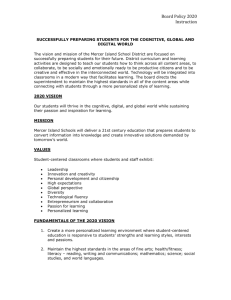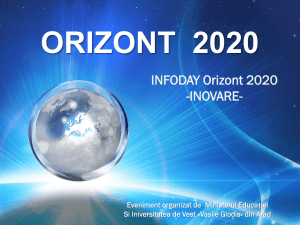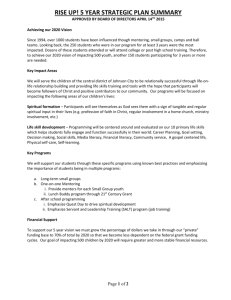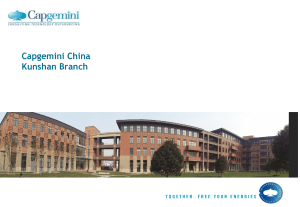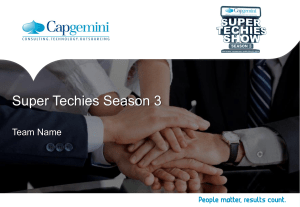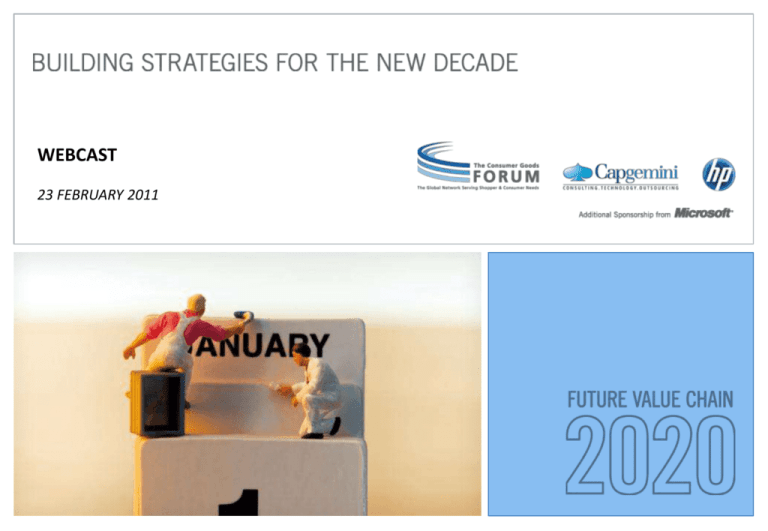
WEBCAST
23 FEBRUARY 2011
THE EVOLUTION OF THE FUTURE VALUE CHAIN
2
2020 Future Value Chain Building Strategies for the New Decade
© 2011 The Consumer Goods Forum, Capgemini, HP. Microsoft . All rights reserved
2020 Future Value Chain: Objectives and Principles
Objectives
- Bring a collective vision to the CP&R Industry
- Ensure the Industry is best prepared to continue
to meet the needs of shoppers and consumers
in a changing world
Principles
- New report every two years
- 10-year perspective
- (Executive) industry expertise via workshops
- Not a consultant project
3
2020 Future Value Chain Building Strategies for the New Decade
© 2011 The Consumer Goods Forum, Capgemini, HP. Microsoft . All rights reserved
2020 Future Value Chain: The Future Value Chain Genesis
2016: A Vision of the Future
Value Chain
2018: Succeeding in a Volatile
Market
2020: Building Strategies for
the New Decade
80 executive participants
Two global workshops
(Utrecht, NL & Chicago, USA)
Follow-up:
‐ 2016 Future Supply Chain
‐ Information Sharing report
‐ New Ways of Working Together
130 executive participants
Global workshop (Utrecht, NL)
Asian workshops:
‐ Hong Kong (Asian region)
‐ Mumbai (Indian market)
‐ Tokyo (Japanese market)
Follow-up:
‐ Succeeding in a Volatile Market
200 executive participants
Global workshops (Chantilly, FR)
Regional workshop
‐ GS1 in Europe (Antwerp, BE)
Country workshops:
‐ Australia (Melbourne)
‐ France (Paris)
‐ Netherlands (Utrecht)
‐ US (Chicago)
‐ Mexico (Mexico City)
4
2020 Future Value Chain Building Strategies for the New Decade
© 2011 The Consumer Goods Forum, Capgemini, HP. Microsoft . All rights reserved
© 2011 The Consumer Goods Forum, Capgemini, HP. Microsoft . All rights reserved
2020 Future Value Chain Framework: Trends, Objectives and Tactics
6
2020 Future Value Chain Building Strategies for the New Decade
© 2011 The Consumer Goods Forum, Capgemini, HP. Microsoft . All rights reserved
TRENDS:
WHAT IS DRIVING OUR OBJECTIVES
7
2020 Future Value Chain Building Strategies for the New Decade
© 2011 The Consumer Goods Forum, Capgemini, HP. Microsoft . All rights reserved
We see rapid changes in societies around the world…
Increased urbanization
Aging population
Today: Half the world‟s population (3 billion people) lives in urban areas
‐ Close to 180,000 people move into cities daily, adding roughly 60 million new urban dwellers each year
Older consumers
‐ Have substantial ecomomic power
‐ Devote greater portion of total expenditure to necessities
‐ May soon represent majority of voting public in many countries
2015: Doubling of cities > 8 million
2020: 8 Megacities (>20 million)
2050: 70% of world population lives in urban centers
Example consequences
‐ Shift to smaller-footprint stores
‐ No room for unproductive
inventory
‐ Supply and logistical challenges
‐ New infrastructures required
10
Example consequences
– Changes to business models to meet
needs of different population
– Review products and processes
(e.g. wider aisles, largeprint labels)
– Shrinking workforce challenges
2020 Future Value Chain Building Strategies for the New Decade
11
Increasing spread of wealth
2020 Future Value Chain Building Strategies for the New Decade
Shifting of economic power
Middle class is rapidly expanding (mostly in developing regions)
2000: 56 % of global middle class in developing countries
2030: 93 % of global middle class in developing countries
Economic powers like China, Brazil and India continue to rise
China overtakes US as world‟s largest economy in 2017
India overtakes Japan as world‟s 3rd largest economy in 2012
Volatile global economy will remain the norm for coming decade
Example Consequences
‐ source of growth for manufacturers
and retailers
‐ Implications for availability and
prices of commodities
‐ Potential protectionistic country
policies
12
2020 Future Value Chain Building Strategies for the New Decade
18
8
2020 Future Value Chain Building Strategies for the New Decade
2020 Future Value Chain Building Strategies for the New Decade
© 2011 The Consumer Goods Forum, Capgemini, HP. Microsoft . All rights reserved
…changes in consumer and shopper behaviour…
Increase in consumer service demands
Increased impact of consumer technology adoption
Shoppers continue to become more empowered using technology
Explosive growth of mobile features and device convergence
‐ 2013: over 2 billion mobile users globally will have purchased via
handsets
Significant changes in consumers‟ behavior and buying behavior
Crucial role of social media
Exponential growth and adoption of consumer technologies
drives new levels of service demands
Rise of stronger web-based service economy
Consumers demand 24/7 service
Online sales will grow to 25 % to 30% of total retail sales
(now: 4 % to 15%)
Example consequences
‐ Growth of mobile interaction and commerce
‐ Consumer technology used in stores
‐ Addressing social communities
‐ Leveraging huge amounts of data
‐ Dealing with privacy
‐ Becoming more transparent and
collaborative towards shoppers
13
Example consequences
‐ More demanding consumers
‐ New service models needed
2020 Future Value Chain Building Strategies for the New Decade
15
Increased importance of health and wellbeing
Growing consumer concern about sustainability
Shoppers want more healthy products and a healthier lifestyle
Emerging consumjer segments like LOHAS
(Lifestyles of Health and Sustainability)
LOHAS In US are approximately 19% of adult population:
41 million consumers
Sales from LOHAS expected to quadruple in five years
Consumers‟ carbon footprint awareness
increases significantly
Regulation carbon footprint increase
significantly
Consumers expect governments and
companies to play major role
US Green marketplace grows from $420
billion in 2010 to $845 billion by 2015
Food, beverage and personal and
household goods sectors particularly
exposed
Waste becomes key focus sustainability
discussion
17
2020 Future Value Chain Building Strategies for the New Decade
16
2020 Future Value Chain Building Strategies for the New Decade
9
2020 Future Value Chain Building Strategies for the New Decade
2020 Future Value Chain Building Strategies for the New Decade
© 2011 The Consumer Goods Forum, Capgemini, HP. Microsoft . All rights reserved
…. and other changes in our environment
Increase in regulatory pressure
Scarcity of natural resources
Demand larger than supply
2030: World population 8.3 billion
‐ Demand for food +50%
‐ Demand for energy +50%
‐ Fresh water demand +30%
Regulatory pressure expected to increase
Hot button areas:
‐ Environment
‐ Sustainability
‐ food safety
Example consequences
‐ Energy revolution
‐ New Water policies
‐ Impact on food prices
‐ Pressures on food quality & Safety
20
21
2020 Future Value Chain Building Strategies for the New Decade
Rapid adoption of supply chain technology capabilities
2020 Future Value Chain Building Strategies for the New Decade
Impact of next-generation information technologies
More synchronized value chain with greater visibility and traceability
‐ Improved collaboration
‐ New supply chain / logistics technologies
‐ Information transparency
Information Technology shifts from indispensable support function
to the way to become adaptive
‐ New ways of business due to next generations of IT
‐ New ways of managing business processes
‐ Major new opportunities for innovation
‐ Freeing up from current IT constraints
Example consequences
‐ Need to improve visibility and
traceability
‐ Need to share information over
company boundaries
‐ Need to adopt right technologies
22
2020 Future Value Chain Building Strategies for the New Decade
10
23
2020 Future Value Chain Building Strategies for the New Decade
2020 Future Value Chain Building Strategies for the New Decade
© 2011 The Consumer Goods Forum, Capgemini, HP. Microsoft . All rights reserved
OBJECTIVES:
WHAT WE WANT TO ACHIEVE
11
2020 Future Value Chain Building Strategies for the New Decade
© 2011 The Consumer Goods Forum, Capgemini, HP. Microsoft . All rights reserved
2020 Future Value Chain: Four Strategic Objectives
Make Our Business More Sustainable
From Niche to Norm
Optimize a Shared Supply Chain
Collaborate Differently, Compete Differently
Engage with Technology-Enabled Consumers
The Consumer in the Driver’s Seat
Serve the Health and Wellbeing of Consumers
Focus on Quality of Life
12
2020 Future Value Chain Building Strategies for the New Decade
© 2011 The Consumer Goods Forum, Capgemini, HP. Microsoft . All rights reserved
1. Make Our Business More Sustainable: From Niche to Norm
Success means consumers trust our industry
Retailers and brand manufacturers collaborate
‐ Tackling big challenges (e.g., deforestation)
‐ Helping consumers understand their role in living an
environmentally friendly lifestyle
Common measures, language and consistent messaging
‐ Helping consumers understand their role
‐ Helping to make the right decisions, enabling a
significant change in consumer behavior
Competitiveness delivered by
‐ Brand and store performance
‐ Breakthrough innovations improving sustainability
Working with upstream suppliers to extend our influence
over many other contiguous industries
13
Success will come
when consumers begin
to trust our industry
2020 Future Value Chain Building Strategies for the New Decade
© 2011 The Consumer Goods Forum, Capgemini, HP. Microsoft . All rights reserved
2. Optimize a Shared Supply Chain: Collaborate Differently, Compete Differently
The 2020 future supply chain reconsiders
assumptions
‐ New parameters include:
• Reduced CO2 emissions
• Energy consumption
‐ Driven by consumers; they are the trigger for
an optimized collaborative supply chain flow
Success will come when supply chain
optimization is treated from a total
value chain perspective rather than
from individual company perspectives
14
2020 Future Value Chain Building Strategies for the New Decade
© 2011 The Consumer Goods Forum, Capgemini, HP. Microsoft . All rights reserved
3. Engage with Technology-Enabled Consumers: The Consumer in the Driver‟s Seat
Consumer technology
‐ Changes lives of consumers
‐ Changes shopping journey
‐ Increases marketplace transparency
Consumers
‐ Demand personalized dialogues and offerings anytime,
anywhere
‐ Embrace technology quicker than the industry
‐ Digital natives are increasingly big consumer base
‐ Digital immigrants also heavily use consumer
technologies
The industry
‐ Needs to figure out how to effectively interact
‐ Needs to be viewed as a trusted source for information
‐ Will be more successful when companies engage
consumers in new product and service development
15
Success will come when we
understand how to maintain a
true dialogue with consumers
via their preferred channels
and technologies
2020 Future Value Chain Building Strategies for the New Decade
© 2011 The Consumer Goods Forum, Capgemini, HP. Microsoft . All rights reserved
4. Serve the Health and Wellbeing of Consumers: Focus on Quality of Life
Health and wellbeing of consumers: physical,
emotional, spiritual, intellectual and sustainable wellbeing
Positive changes in consumer behavior
‐ Healthy choices available for all budget levels
‐ Information/education to make informed choices
Improved availability and quality of water and hygiene
‐ Reduce diseases and infant mortality rate
To be established via a new way of working together
‐ Governments, consumer goods companies,
pharmaceutical companies and NGOs
‐ Enabling new business models
‐ Enabling a dialogue to collaboratively work on
concrete solutions
16
Success will come when
we focus on “better lives
through better business”
2020 Future Value Chain Building Strategies for the New Decade
© 2011 The Consumer Goods Forum, Capgemini, HP. Microsoft . All rights reserved
TACTICS:
HOW WE WILL ACHIEVE OUR OBJECTIVES
AS AN INDUSTRY
17
2020 Future Value Chain Building Strategies for the New Decade
© 2011 The Consumer Goods Forum, Capgemini, HP. Microsoft . All rights reserved
2020 Future Value Chain: The Consumer Goods Forum‟s Strategic Pillars
18
2020 Future Value Chain Building Strategies for the New Decade
© 2011 The Consumer Goods Forum, Capgemini, HP. Microsoft . All rights reserved
HOW TO USE
THE FUTURE VALUE CHAIN
IN YOUR COMPANY
19
2020 Future Value Chain Building Strategies for the New Decade
© 2011 The Consumer Goods Forum, Capgemini, HP. Microsoft . All rights reserved
You can already be inspired by a lot of good example initiatives across the industry
Illustrative Examples
Make Our Business
More Sustainable
Optimize a Shared
Supply Chain
Unilever Collaborates with Walmart (ASDA)
to Create Awareness and Educate Customers
on Sustainable Living
Colgate-Palmolive (as many other
Companies) Uses Global Data
Synchronization to Standardize Business
Processes, Drive Efficiency and Enable
Faster Innovation
METRO Group Develops a Sustainable
Aquaculture Program for Fish in the
Mekong Delta in Vietnam
United Biscuits and Nestlé Collaborate to Generate
Significant Environmental and Cost Savings
Many Consumer Product
Companies are Committed Towards
Sustainable Production of Palm Oil
Mars and Kuehne + Nagel Measure and
Visualize Order Placement Impact to Gain
Environmental Benefits and Improve
Efficiency
Coca-Cola Hellenic Runs Energy-Efficient
Plants that Reduce CO2 Emissions
Albert Heijn Uses Dynamic Pricing and Digital
Signage to Reduce Waste on Fresh Produce
Danone Works with Carrefour to Improve
On-Shelf Availability and to Leverage
Supply-Driven Shopper Insights
Kraft Develops “Eco-Calculator” to Optimize Packaging
and Track and Reduce Energy Usage for Its Products
20
2020 Future Value Chain Building Strategies for the New Decade
© 2011 The Consumer Goods Forum, Capgemini, HP. Microsoft . All rights reserved
You can already be inspired by a lot of good example initiatives across the industry
Illustrative Examples
Engage with
Technology-Enabled
Consumers
Serve the Health
and Wellbeing of
Consumers
PepsiCo Successfully Engages a Large
Customer Base to Interact in Product
Development
CFBAI Initiative Seeks to Address the Problem of
Childhood Obesity by Self-Regulating Advertising to
Children under 12 Years
Product Recall Service of GS1 in U.S. and
Canada Has Helped to Build an Efficient
Process for Handling Product Recalls
Coca-Cola in Japan Uses Interactive
Vending Machines to Increase
Consumer Engagement
Nestlé Helps Raise Awareness about the Importance
of Proper Nutrition and Health and Wellness to
Children through Its Healthy Kids Global Program
Starbucks and L‟Oreal Interact with Customers
through an Innovative Mobile Marketing
Solution Offered by O2 Mobile in UK
Hindustan Unilever Limited Educates Rural
Women to Enter the Growing Consumer
Market in Rural India
Unilever and Albert Heijn Jointly Work on
Strategic Activation Platforms, Using
Shopper Insights to Drive Joint Growth
Walmart Collaborates to Make Technology
More Accessible and Affordable for Small
Health Practices
21
2020 Future Value Chain Building Strategies for the New Decade
© 2011 The Consumer Goods Forum, Capgemini, HP. Microsoft . All rights reserved
How Robust Is Your Strategy?
Make Your Business More Sustainable
Will you drop product lines that are fundamentally not
sustainable?
Do you have a contingency plan for an unexpected ecodisaster or climatic disruption?
Do you have programs in place to address, for example,
restrictions on truck emissions, access to urban zones and
noise pollution?
Are you prepared to transparently report the detail of your
company‟s environmental impact?
Engage with Technology-Enabled Consumers
Do you know how to survive a negative social
network viral fan page?
Is your company really differentiating between a
“shopper” and “consumer”?
Do you know who else is providing information about
your brands or stores to consumers or shoppers?
How do you create transparency with consumers while
maintaining control?
Optimize a Shared Supply Chain
Do you still see your supply chain as a source of
competitive advantage?
Would you share a truck or a warehouse with a competitor?
Is your supply chain able to cope with the impact of oil
returning to its 2008 historical high of $147 a barrel? Or
even exceeding that, and hitting $200?
Are you willing to share non-competitive information with
trading partners – including competitors – about product
movements along the supply chain?
Serve the Health and Wellbeing of Consumers
Are your products creating the health crisis rather
than solving it?
Are you prepared to meet the new demands of older
consumers?
Do you know where you will get your labor force once
your current labor force retires?
How will you efficiently serve the underserved customers
in developing markets?
22
2020 Future Value Chain Building Strategies for the New Decade
© 2011 The Consumer Goods Forum, Capgemini, HP. Microsoft . All rights reserved
Q&A
We welcome your Questions …
Three Ways Companies Can Leverage the Future Value Chain in their Own Business
1. Apply the Future Value Chain framework inside your company
What are the trends that impact my company‟s objectives?
What strategic objectives should we have inside our company?
What tactics do we need to put into place to achieve the objectives?
2. Implement the relevant tactics and ideas from the Future Value Chain initiative
Existing company programs address strategic objectives
3. Challenge yourself to see how robust your strategy really is to:
Make your business more sustainable
Optimize a shared supply chain
Engage with technology-enabled consumers
Serve the health and wellbeing of consumers
24
2020 Future Value Chain Building Strategies for the New Decade
© 2011 The Consumer Goods Forum, Capgemini, HP. Microsoft . All rights reserved
The program sponsors can help you with a „Future Value Chain Discovery Day‟
workshop that will lead you from Inspiration toward a concrete Roadmap
Future Value Chain
Discovery-day
‘Building Strategies for the
New Decade’
Building Strategies
for the New Decade
Inspiration by concrete
business solutions and best-inclass reference examples
Blending with companyspecific issues and initiatives in
an unconventional facilitated
process
Resulting at the end of the day
in a high level roadmap that fits
your business context
© 2011 The Consumer Goods Forum, Capgemini, HP. Microsoft . All rights reserved
Contact details
The Consumer Goods Forum
Sabine Ritter
The Consumer Goods Forum
+33 1 82 00 95 80
s.ritter@theconsumergoodsforum.com
Capgemini
Kees Jacobs
Capgemini
+31 653 292 832
kees.jacobs@capgemini.com
Marc van der Liet
The Consumer Goods Forum
+33 1 82 00 95 84
m.vanderliet@theconsumergoodsforum.com
Brian Girouard
Capgemini
+1 952 212 0417
brian.girouard@capgemini.com
HP
Mario Vollbracht
HP
+1 404 551 5872
mario.vollbracht@hp.com
Microsoft
Ted Combs
Microsoft
+1 630 725 4319
tedcombs@microsoft.com
www.hp.com/go/retail
www.hp.com/go/consumergoods
David Bailey
Microsoft
+44 118 909 4566
davidbai@microsoft.com
26
2020 Future Value Chain Building Strategies for the New Decade
© 2011 The Consumer Goods Forum, Capgemini, HP. Microsoft . All rights reserved
www.FutureValueChain.com
www.theconsumergoodsforum.com
www.capgemini.com
www.hp.com
www.microsoft.com
©2011 The Consumer Goods Forum, Capgemini, HP, Microsoft. All rights reserved.




